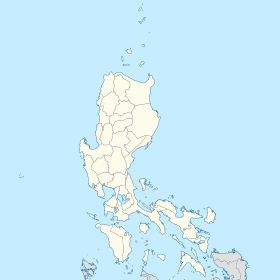Colors of StoBoSa
| Colors of StoBoSa | |
|---|---|
| StoBoSa Hillside Homes Artwork | |
 The artwork in 2017. | |
| Artist | Concept Tam-awan Artist Village Paintwork 520 volunteers |
| Year | 2016 |
| Medium | Paint |
| Subject | Sunflowers and rainbows |
| Dimensions | More than 18,000 m2 (190,000 sq ft) (~150-200 houses) |
| Designation | Officially designated as a tourist attraction by the La Trinidad municipal government. |
| Location | La Trinidad, Benguet, Philippines |
| 16°26′03.8″N 120°35′51.2″E / 16.434389°N 120.597556°E | |
The Colors of StoBoSa, officially designated as the StoBoSa Hillside Homes Artwork, is a community artwork designed by the Tam-awan Village group, and is a locally recognized tourist attraction in the town of La Trinidad, Benguet. The paintwork of multiple houses composes the single artwork.
Name and location[edit]
The artwork is known as the StoBoSa Hillside Homes Artwork,[1] which is also the official designation for the artwork by the municipal government,[2] and is also called simply as the Colors of StoBoSa.[3] "Stobosa" is a portmanteau of the names of the sitios the artwork is situated namely Stonehill, Botiwtiw, and Sadjap. The three localities are all within Barangay Balili.[3]
Background[edit]
The artwork was commissioned as part of the Rev-Bloom Urban Redevelopment Tourism Campaign a project conceptualized by the Department of Tourism-Cordillera Administrative Region (DOT-CAR) under Regional Director Venus Tan and the La Trinidad local government under Edna Tabana.[4]
Conceptualization[edit]

The design of the artwork was conceptualized by Tam-awan Artist Village group by the Chanum Foundation[5] led by solar artist Jordan Mang-osan[4] along with Niño Jose B. Seriosa as the Graphic Artist[citation needed], Ged Alangui, Clinton Aniversario, and Jenny Lorenzo.[3] Gloria Agasen was the project coordinator.[6]
Based on favela paintings of Brazil, the making of the Colors of Stobosa involved the painting of around 150[6]-200 houses or an area of 18,000 square meters (190,000 sq ft).[7] It is a combination of four designs made by the Tam-Awan Village artists. The designs, perceived as easy to make and aesthetically pleasing, were selected from a multitude of designs. The sunflower was chosen as a main motif of the artwork since the area used to be a full of the flowering plant.[6] Rainbows also form part of the design.[8]
Paintwork[edit]


Painting of the artwork began in February 2016 and was inaugurated on June 23, 2016 though it was only projected to be completed by August 2016.[3] At the time of its unveiling the artwork was already 80 percent complete.[5]
520 people,[7] being residents of the three sitios as well as volunteers, painted the houses.[6] They underwent training which started in January 2016.[8] The outlines were applied after the color within them were painted.[6] The 2,800 gallons[specify] of paint[9] costing ₱2 million used were provided by local paint firm, Davies Paints,[10] while other painting materials were provided by the local government.[7]
The painting has a projected life expectancy of five years and a retouching of the work is planned in mid-2018.[7][needs update]
Recognition[edit]
The artwork is officially recognized as a tourist attraction of La Trinidad, Benguet by the municipal government.[2] The recognition was given to the artwork through Sangguiniang Bayan (transl. Municipal Council) Resolution No. 130 which was adopted on July 12, 2016. The resolution was sponsored by councilors Roderick Awingan, Estrella Adeban, and Henry Kipas.[11]
Similar projects[edit]
The Department of Tourism plans a similar project in the neighboring city of Baguio. The endeavour is called Project Puraw which involves the painting of houses in Quirino Hill.[12][needs update]
References[edit]
- ^ Pasogoy, Mark Victor (2 September 2016). "Other improvements eyed in La Trinidad's Stobosa". Sun.Star Baguio. Retrieved 12 January 2018.
- ^ a b Pasagoy, Mark Victor (22 July 2016). "StoBoSa enlisted as a new attraction". Sun Star Baguio. Retrieved 12 January 2018.
- ^ a b c d Lapniten, Karl (23 June 2016). "Artists turn Benguet hillside homes into mural". CNN Philippines. Archived from the original on 28 June 2016. Retrieved 12 January 2018.
- ^ a b Lacsamana, Hanna (26 June 2016). "LT unveils giant mural landscape". Baguio Midland Courrier. Retrieved 12 January 2018.
- ^ a b Quitasol, Aldwin. "Benguet houses painted à la Favela ready to attract tourists". InterAksyon. Archived from the original on 28 July 2016. Retrieved 12 January 2018.
- ^ a b c d e Comes, Mae (21 June 2016). "Benguet houses turned into colorful mural". ABS-CBN News (in English and Filipino). Retrieved 12 January 2018.
- ^ a b c d "La Trinidad residents unite to beautify their local community". Rappler. 24 June 2016. Retrieved 12 January 2018.
- ^ a b Quitasol, Kimberlie (11 January 2016). "Benguet art mural of favelas planned". Inquirer Northern Luzon. Retrieved 12 January 2018.
- ^ Quitasol, Kimberlie (10 July 2016). "Paint manufacturer adds color to the countryside". Inquirer Northern Luzon. Retrieved 12 January 2018.
- ^ Polonio, Jessa Mardy (26 June 2016). "PH destinations developed into paint colors". Sun Star Baguio. Retrieved 12 January 2018.
- ^ "Resolutions 2016". Sangguniang Bayan of La Trinidad. Retrieved 12 January 2018.
- ^ "Quirino Hill approves DOT's Project Puraw, now in pastel". Baguio Midland Courier. Retrieved 12 January 2018.
External links[edit]
 Media related to Colors of StoBoSa at Wikimedia Commons
Media related to Colors of StoBoSa at Wikimedia Commons


